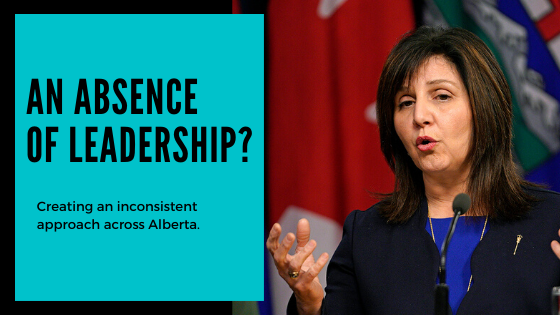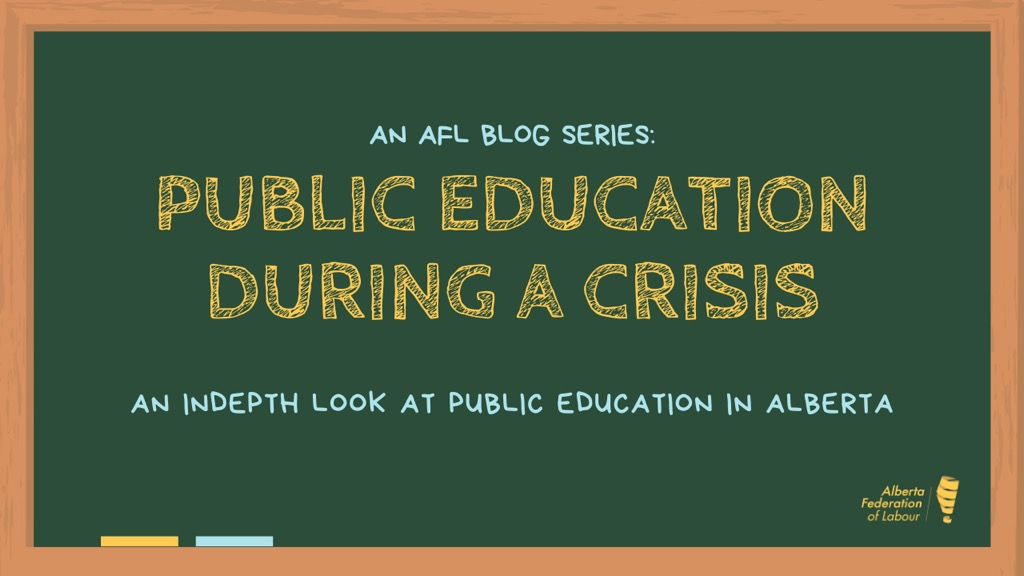Part 4: Online Learning: Widening Inequity and an Absence of Leadership
On March 15, as a result of the growing COVID-19 pandemic, Education Minister Adriana LaGrange announced schools across Alberta would be closed. This Sunday announcement caused significant stress for many families who now had mere hours to make arrangements for children to stay home indefinitely.

School’s Out for Summer?
At first, the news of school closures sounded like an extended March break that would likely meet an early summer holiday. Students would both complete their year with a final grade, and as expressed by the Minister herself – “will be able to move to the next grade in the fall”.
It seemed like school was out. Families and children could focus on dealing with the global health pandemic and as a collective we would ensure all children would begin receiving a quality education when it was safe to do so.
Yet instead of giving families and students space and time to deal with the pandemic, schools, as early as two days into school closures, sent families emails about how to continue schooling, of new websites, of assignments and projects. Some schools assumed a business as usual approach, other schools awaited further instructions.
The response was inconsistent and uncoordinated.

Widening Inequity
The rush to continue delivering education online during a crisis has historically left many children behind, widened inequity, and created an environment that makes existing gaps in the system far worse. The gaps also create the perfect breeding ground for privatization. Alberta is no exception.
Minister LaGrange announced guidelines which created clear recommendations on the number of hours of work students were expected to have per week. But not enough consideration was given to how crisis online learning would affect so many families. And inequities that always existed bubbled up to the surface very quickly. Including:
Technology
Many families across Alberta simply do not have access to the technology to adequately equip students for online learning. This includes access to laptops, printers, scanners, as well as, adequate WiFi. This is especially difficult in some rural areas.
School boards are doing the best they can with limited resources, lending out laptops, making paper packages available, and in the case of a school board in Ontario, telling families that WiFi will be available to them in school parking lots. Imagine being financially insecure, physically stressed, mentally exhausted – and being told the solution is to drive to the school parking lot to access WiFi.
These are all solutions to the problem of availability. They overlook the inequity of making marginalized families jump through MORE hoops to access resources – when we should be finding ways to eliminate the hoops altogether.
Household Support
Crisis online learning requires support. Eight-year-olds are not currently proficient at creating PDFs, scanning, saving and then uploading to a Google drive. These activities require support. That support usually comes from a parent.
However, not all parents are able to provide this support, some not having the technological proficiency and some struggling with English as an additional language. Other parents may still be working, often more hours than they historically have and other parents may in fact be sick themselves. Think of the single parent who also happens to be an essential service worker, whose kids are now living with their grandparents in order to keep them safe.
This kind of support also ignores that we are in a global health pandemic that has left many families uncertain how they will afford rent, or food for the coming weeks.
Educational Supports
Teachers and educators are undoubtedly putting forward incredible effort to keep things moving forward, maintaining relationships with their students, and providing a sense of familiarity, but there are students who also relied on education assistants to meet their special needs. Minister LaGrange fired 25,000 education workers including educational assistants, speech pathologists, occupational therapists and psychologists, leaving an enormous gap for students in need of extra support.
Time
For many children and families, moving to online learning is both new and challenging. This is likely true for some teachers as well. Handing in an assignment, making a video, creating and learning from online content has a steep learning curve. Many families are struggling to balance working from home and navigating online learning, finding it unsustainable. Many families are opting out entirely. Even the ability to opt out as a conscious decision is a privilege in and of itself.
Safety
The ability to supervise children on the internet is also an important consideration. The once common advice for parents was to monitor closely how children were spending their time online. Little consideration has been given about the online safety of children’s data. Online education and tech companies stand to benefit exponentially from the rush to crisis online learning, data mining information on students across the globe.

An Absence of Leadership?
Information and guidelines exist on best practices for crisis responses to education: COVID-19 and school closures: What can countries learn from past emergencies?
Had the government of Alberta taken three weeks to determine the core goals of education, school boards could have prioritized relationships, play-based learning, mental health, and knowledge. There could have been a consistent approach across boards that met the needs of the most marginalized students.
But in the absence of focused leadership from Minister LaGrange, there was an inconsistent approach across Alberta.
Many education advocates, and parents living through this elsewhere, echo the idea that now is not the time to introduce new concepts, or forge ahead business as usual, but rather build upon existing skills, master concepts from previous grades, maintain and reinforce relationships with teachers and classmates, free of academic stresses. And of course make time for reading, baking, and building.
This crisis presents an opportunity for “disaster capitalism” to take a hold of public education in Alberta, but there is an equal opportunity now to redefine and refocus public education in ways that address these systemic inequities. This will be the topic of the next blog.
*The Alberta Federation of Labour is producing a blog series which looks at what happens to public education during a time of crisis. We will evaluate what the Alberta government is doing during this global pandemic, and examine how governments can choose to either strengthen our public system, or use a time of crisis as a catalyst to attack, undermine, and privatize our public education This is Part 4 in the series.

